#P J Monahan art
Explore tagged Tumblr posts
Text

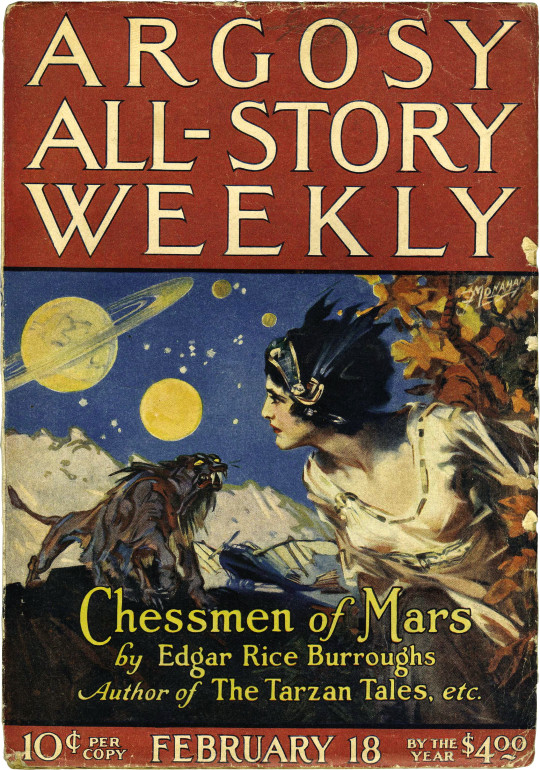
"Chessmen of Mars" Argosy All-Story Weekly, February 18, 1922 Cover by P. J. Monahan
#p. j. monahan#pj monahan#vintage#chessmen of mars#1922#1920s#scifi#scifi art#science fiction#science fiction art#art#illustration#painting
126 notes
·
View notes
Text
Social Change #1- Homelessness at an All-Time High


The Portland Homeless Crisis P:1
Asia Lumoya-Wills
UNST-242A
Portland, the city of roses. Known for its coffee, art, and unfortunately a homeless epidemic. In recent years, the number of homeless in the Portland metro area has skyrocketed, becoming a large social issue in the area. The statistics behind this recent surge are shocking. According to an article written by Nicole Hayden, “The number of people experiencing homelessness in Oregon grew nearly 23% during the two-year span, increasing by 3,304 people to about 18,000” (Hayden, 2023). This jump occurred from 2020-2022. The Portland government page lists another statistic showing the rise in homelessness from 2015-2023 was 65% (Portland, 2023). These alarming numbers tell the story of how Portland’s homeless numbers have risen out of control. By definition, homelessness is “homelessness is “the situation of an individual, family, or community without stable, safe, permanent, appropriate housing, or the immediate prospect means and ability of acquiring it” (Homeless, 2021). I feel like this is a solid definition of what homelessness is, but I think it’s also important to note the importance of the homeless crisis. The statistics listed above clearly prove this issue isn’t solved. If anything, the issue of homelessness in Portland is continuing to worsen year after year. This is important because homelessness doesn’t only affect the individuals who are unhoused. This crisis also affects a multitude of other people as well. The rise in homelessness has had a huge impact on local business owners. For one, Portland is earning a reputation as a metro area with a homeless problem. This common view of Portland steers tourism away from the city and can hurt the economy. Homeless individuals roaming the streets can also deter individuals visiting the city from going out and thoroughly exploring it, once again limiting the ability for business owners to make money. This issue also affects the people who live in the Portland area and enjoy visiting the city. As mentioned above, the homeless crisis has had an economic impact on the city. Rachel Monahan wrote an article in the Willamette Week stating that "Economic displacement" has contributed to the loss of Portland-area bus riders, TriMet officials wrote in a Nov. 14 post for Transit Center, a foundation focused on city transportation” (Monahan, 2017). A combination of an increased number of homeless present on tri met transportation in conjunction with a decreased number of drivers has led to an extreme decline in the usage of public transportation in the Portland area. Another way the increase in homeless is affecting the Portland metro area is the nature. With the increased number of homeless, unhoused individuals have relocated in wildlife or nature areas. Although the city is making efforts to prevent homeless tents from cropping up in these areas, the fact is homeless people have turned these parks into their homes. This issue is important and pressing because it affects anyone who lives in the Portland metro. Actions need to be taken as soon as possible to turn this crisis around. Both the homeless and everyone living in the Portland area will massively benefit from efforts made to decrease the number of homeless in Portland.
Citations:
Homelessness. Portland.gov. (n.d.). https://www.portland.gov/wheeler/homelessness
Oregonian/OregonLive, N. H. | T., & Oregonian/OregonLive, J. G. | T. (2023, April 5). Oregon’s recent growth in homelessness among largest in nation. oregonlive. https://www.oregonlive.com/politics/2023/04/oregons-recent-growth-in-homelessness-among-largest-in-nation.html
TriMet blames “economic displacement” for decline in Portland-area bus riders. Willamette Week. (n.d.). https://www.wweek.com/news/city/2017/11/18/trimet-blames-economic-displacement-for-portland-area-decline-in-bus-riders/
What is homelessness?. What is Homelessness? | The Homeless Hub. (n.d.). https://www.homelesshub.ca/about-homelessness/homelessness-101/what-homelessness
1 note
·
View note
Text

Judge Nov 24 1923
Enoch Bolles

Love Story Magazine Nov 24 1923
Patrick J Monahan
#golden age art#pulp magazine art#pulp art#pulp art 1923#Judge#Enoch Bolles art#Love Story Magazine#P J Monahan art#byronrimbaud
15 notes
·
View notes
Text
SOLUTION AT Academic Writers Bay Gail P. Hiduke J. D. Ryan Saddleback College Emeritus, Irvine Valley College Australia • Brazil • Japan • Korea • Mexico • Singapore • Spain • United Kingdom • United States Copyright 2013 Cengage Learning. All Rights Reserved. May not be copied, scanned, or duplicated, in whole or in part. Due to electronic rights, some third party content may be suppressed from the eBook and/or eChapter(s). Editorial review has deemed that any suppressed content does not materially affect the overall learning experience. Cengage Learning reserves the right to remove additional content at any time if subsequent rights restrictions require it. This is an electronic version of the print textbook. Due to electronic rights restrictions, some third party content may be suppressed. Editorial review has deemed that any suppressed content does not materially affect the overall learning experience. The publisher reserves the right to remove content from this title at any time if subsequent rights restrictions require it. For valuable information on pricing, previous editions, changes to current editions, and alternate formats, please visit www.cengage.com/highered to search by ISBN#, author, title, or keyword for materials in your areas of interest. Copyright 2013 Cengage Learning. All Rights Reserved. May not be copied, scanned, or duplicated, in whole or in part. Due to electronic rights, some third party content may be suppressed from the eBook and/or eChapter(s). Editorial review has deemed that any suppressed content does not materially affect the overall learning experience. Cengage Learning reserves the right to remove additional content at any time if subsequent rights restrictions require it. Small Business: An Entrepreneur’s Business Plan, Ninth Edition Gail P. Hiduke and J. D. Ryan Senior Vice President, LRS/Acquisitions & Solutions Planning: Jack W. Calhoun Editorial Director, Business & Economics: Erin Joyner © 2014, 2009 South-Western, Cengage Learning ALL RIGHTS RESERVED. No part of this work covered by the copyright herein may be reproduced, transmitted, stored, or used in any form or by any means graphic, electronic, or mechanical, including but not limited to photocopying, recording, scanning, digitizing, taping, Web distribution, information networks, or information storage and retrieval systems, except as permitted under Section 107 or 108 of the 1976 United States Copyright Act, without the prior written permission of the publisher. Senior Acquisition Editor: Michele Rhoades Developmental Editor: Ted Knight Editorial Assistant: Tamara Grega Market Development Manager: Jonathan Monahan Marketing Coordinator: Michael Saver For product information and technology assistance, contact us at Cengage Learning Customer & Sales Support, 1-800-354-9706 For permission to use material from this text or product, submit all requests online at www.cengage.com/permissions Further permissions questions can be e-mailed to [email protected] Brand Manager: Robin LeFevre Executive Marketing Communications Manager: Jason LaChapelle Art and Cover Direction, Production Management, and Composition: PreMediaGlobal Media Editor: Rob Ellington Rights Acquisition Director: Audrey Pettengill Rights Acquisition Specialist, Text and Image: Amber Hosea Library of Congress Control Number: 2012948803 ISBN-13: 978-1-285-16995-8 ISBN-10: 1-285-16995-6 South-Western 5191 Natorp Boulevard Mason, OH 45040 USA Manufacturing Planner: Ron Montgomery Cover Image: © iStockphoto/Image Source Cengage Learning is a leading provider of customized learning solutions with office locations around the globe, including Singapore, the United Kingdom, Australia, Mexico, Brazil, and Japan. Locate your local office at: www.cengage.com/global Cengage Learning products are represented in Canada by Nelson Education, Ltd. For your course and learning solutions, visit www.cengage.com Purchase any of our products at your local college store or at our preferred online store www.
cengagebrain.com Printed in the United States of America 1 2 3 4 5 6 7 17 16 15 14 13 Copyright 2013 Cengage Learning. All Rights Reserved. May not be copied, scanned, or duplicated, in whole or in part. Due to electronic rights, some third party content may be suppressed from the eBook and/or eChapter(s). Editorial review has deemed that any suppressed content does not materially affect the overall learning experience. Cengage Learning reserves the right to remove additional content at any time if subsequent rights restrictions require it. brief contents Image_Source/iStockphoto.com Chapter 1 Your Great Adventure 1 Chapter 2 Spotting Trends and Opportunities 25 Chapter 3 Opportunity Selection 61 Chapter 4 Profiling Your Target Customer 89 Chapter 5 Reading and Beating the Competition 120 Chapter 6 Location and Distribution 147 Chapter 7 Connecting with and Engaging Customers 174 Chapter 8 Start-Up Concerns and Financial Projections 200 Chapter 9 Shaking the Money Tree 234 Chapter 10 Legal Concerns 267 Chapter 11 Build, Maintain, and Thrive with a Winning Team 297 Chapter 12 Protect Your “Baby” and Yourself 323 Chapter 13 Buying a Business 346 Chapter 14 Investigating Franchising 380 Chapter 15 Pull Your Plan Together 411 Appendix A Fast-Start Business Plan 434 Appendix B Annie’s Business Plan Proposal 445 Appendix C Forms, Forms, Forms 459 Index 481 iii Copyright 2013 Cengage Learning. All Rights Reserved. May not be copied, scanned, or duplicated, in whole or in part. Due to electronic rights, some third party content may be suppressed from the eBook and/or eChapter(s). Editorial review has deemed that any suppressed content does not materially affect the overall learning experience. Cengage Learning reserves the right to remove additional content at any time if subsequent rights restrictions require it. contents Image_Source/iStockphoto.com Chapter 1 Your Great Adventure Building Your Road Map Target the Chapters that Call to You 2 Jump-Start with Entrepreneurial Links 1 Environmental Variables 2 Changing Household Structures and Demographics 31 6 Web Link Starting Points 6 Knocking at the Entrepreneurial Doors 7 What About These Three Doorways? 7 The Age of the Entrepreneur What Type of Entrepreneur Do You Want to Be? 9 Rev Up 11 Ready to Start? 11 Why Today Is the Day to Begin Your Venture 12 What Is Your Current Family and Financial Picture? What Does It Take to Be an Entrepreneur? Entrepreneurial Success 17 Defining Business Success and Doing Quick and Dirty Numbers 21 Interviewing Successful Entrepreneurs 22 Chapter 2 Boomer Explosion 36 Millenials Rising iGeneration Always Connected 39 41 The Splintering of the Mass Market 42 Franchises Respond to Social and Cultural Changes Entrepreneur Magazine’s Top Ten New Franchises for 2012 44 Entrepreneur Magazine’s Top Ten Fastest-Growing Franchises for 2012 44 9 29 44 Information Explosion 44 Technology Revolution Information Is Everywhere 45 50 Secondary Research 50 Primary Research 54 New Eyes Research 55 13 14 The Big Picture Mind Mapping Your Way into Small Business Brainstorming Techniques 55 Life-Cycle Stages 58 56 57 Summary 22 Summary Think Points for Success 59 60 Think Points for Success Key Points from Another View 23 23 Action Steps Key Terms 60 60 Action Steps 24 Key Terms 24 Opportunity Selection 61 Welcome to Opportunity Selection 62 Spotting Trends and Opportunities 25 Opening Your Eyes and Mind to Vast Opportunities 26 It’s a Dynamic World 27 Chapter 3 Industry Research 64 Conducting Secondary Research for Your Selected Industry 68 iv Copyright 2013 Cengage Learning. All Rights Reserved. May not be copied, scanned, or duplicated, in whole or in part. Due to electronic rights, some third party content may be suppressed from the eBook and/or eChapter(s). Editorial review has deemed that any suppressed content does not materially affect the overall learning experience. Cengage Learning reserves the right to remove additional content at any time if subsequent rights restrictions require it.
v Contents Key Points from Another View 117 Action Steps Key Terms 119 119 Reading and Beating the Competition 120 76 Who Is Your Competition? 122 77 Competitive Touchpoint Analysis Competitive Intelligence 123 125 Continue Scouting the Competition 127 Trade Associations 69 Trade Shows 72 Additional Secondary Resources for Research and Opportunity Gathering 74 Virtual Communities 75 Primary Research on Your Selected Industry Industry Segmentation and Gap Analysis Chapter 5 More Brainstorming for Possible Solutions 78 Matrix Analysis 79 Taking Stock 80 Chapter 4 Design Thinking 80 Define Your Business What Business Are You Really In? 82 81 Secondary Research Sources and Reports Library and Internet References for Companies and Industries 131 Research for Manufacturers and Scientific Firms Competition and Positioning 134 131 Begin to Develop Your Elevator Pitch 83 Feasibility Analysis Summary 84 86 Think Points for Success Key Points from Another View 86 87 Competition and the Product Life Cycle 137 Action Steps 88 Key Terms 88 Competition and Positioning in a Mature Market 139 134 Create a New Arena 141 Create Uniqueness Through Change Profiling Your Target Customer 89 The Power of Profiling 91 Summary 144 What Can We Learn from Published Sources? 95 Think Points for Success Key Points from Another View 144 145 Action Steps 146 Key Terms 146 You Can Do It! 142 Reviewing the Media Kit 97 Changing Profiles 99 Profiling in Action 100 Profiling Business to Business (B2B) Customers 109 Primary Research Is Absolutely Necessary 111 Field Interviews 111 Observing Target Customers Surveys Make Customer Profiling a Reflex Visualizing Your Target Customer Summary Think Points for Success 112 113 Chapter 6 Location and Distribution 147 Channels of Distribution Home Office Option 148 152 Coworking Space Incubators 154 155 Business Incubators 155 114 Bricks-and-Mortar Location for Retail and Service Ventures 115 117 Retail Location Filter Target Customers 159 Neighbor Mix 159 Competition 159 117 142 Copyright 2013 Cengage Learning. All Rights Reserved. May not be copied, scanned, or duplicated, in whole or in part. Due to electronic rights, some third party content may be suppressed from the eBook and/or eChapter(s). Editorial review has deemed that any suppressed content does not materially affect the overall learning experience. Cengage Learning reserves the right to remove additional content at any time if subsequent rights restrictions require it. 156 159 vi Contents Security, Safety, and Parking 159 Labor Pool and Education 160 Restrictions and Opportunities 160 Services 160 Costs 160 Ownership 160 Present and Past Tenants 160 Space 160 History of the Property 160 Taxes 161 Approvals 161 Physical Visibility 161 Life-Cycle Stage of the Area 161 Community Support 161 Image 161 Retail and Service Business Location Information 162 Role of Agents and Brokers 163 Why You Should Network 183 Networking Organizations 185 Additional Promotional Elements Paid Media Advertising 187 Point-of-Purchase Displays 189 Packaging 189 Catalogs 189 Catalog Houses 190 Direct Mail 190 Money-Back Guarantees 191 Trade Shows 192 Other Sales and Marketing Material 192 Blogs 192 Working Visibility 192 Personal Selling 193 Anticipate the Unexpected 164 Before You Sign a Lease 165 How to Rewrite a Lease with Your Lawyer’s Assistance 165 Additional Location Decision for Manufacturers Chapter 7 187 Sales Reps as Connectors Small Business Website 194 195 Attach Price Tags to Your Promotional Strategies Summary 197 197 Think Points for Success Key Points from Another View 198 198 Action Steps 199 Key Terms 199 Start-Up Concerns and Financial Projections 200 Chart Your Business Future with Numbers 201 167 Alternative Retail Locations Swap Meets and Fairs 167 Kiosks 168 QVC 168 167 Internet 169 Summary Think Points for Success 170 171 Key Points from Another View Action Steps 172 173 Key Terms 173 Connecting with and Engaging Customers 174 Marketing Overview 176 Promotional
Strategies Exceptional Customer Service as Promotion What Is Your Customer Worth? 182 180 Free Ink and Free Air Networking 182 183 180 Chapter 8 Start-Up Costs 202 Pricing 202 Seasonality Scenarios 202 Sales Projections and What-If Scenarios 203 Projected Income and Cash Flow Statements 204 Balance Sheet 204 Break-Even Analysis 204 Financial Ratios 204 Start-Up Costs and Concerns Bootstrapping Tips to Conserve 206 Seeking Financial Advice and Support 208 204 206 Pricing Your Product or Service 209 Common Pricing Methods 211 Pricing Strategies 213 Copyright 2013 Cengage Learning. All Rights Reserved. May not be copied, scanned, or duplicated, in whole or in part. Due to electronic rights, some third party content may be suppressed from the eBook and/or eChapter(s). Editorial review has deemed that any suppressed content does not materially affect the overall learning experience. Cengage Learning reserves the right to remove additional content at any time if subsequent rights restrictions require it. vii Contents Seasonality Scenarios 213 Venture Capital Firms 255 Economic Cycles Sales Projections and What-If Scenarios 216 218 Social Entrepreneurship Funding Summary 264 264 Income Statement and Cash-Flow Projections 219 Think Points for Success Key Points from Another View 264 264 Balance Sheet 226 Break-Even Analysis Leaving a Paper Trail and Software Applications Financial Ratios 227 Action Steps Key Terms 266 266 Legal Concerns 267 IT Pays to Look Ahead 268 228 229 Chapter 10 Current Ratio 230 Quick (Liquidity) Ratio 230 Return on Investment 230 Chapter 9 Summary Think Points for Success 230 232 Key Points from Another View Action Steps 232 233 Key Terms 233 Hire an Experienced Attorney at the Beginning 269 Understanding How Lawyers Operate and Reducing Your Legal Costs 270 Which Organiztional Structure Is Best for You? Evaluating Business Structures Credit Reporting Agencies: What Do They Know About You? Cautionary Steps 238 Your Bottom Line 242 272 Sole Proprietorships 273 Partnerships 273 Limited Liability Companies 276 Corporations 276 Subchapter S Corporations 277 Nonprofit Corporations 280 Shaking the Money Tree 234 Before Committing Money Determine Your Risk Tolerance 237 271 237 Family Businesses 280 Trademarks, Copyrights, and Patents Licensing Your Product 283 292 242 Summary Think Points for Success 295 295 Self-Financing Your Money and Your Credit 243 243 Key Points from Another View 295 Action Step Key Terms 296 296 Family and Friends 244 Banks 245 Shaking the Most Fruitful Branches First 237 Lenders’ Expectations 247 Strategies for Working with Your Banker 247 Make Your Banker a Member of Your Team 248 SBA Programs SBA/Bank Financing Checklist 251 SBA Loan Application Checklist 251 249 Vendor Financing Angels with Money 252 253 Chapter 11 Build, Maintain, and Thrive with a Winning Team 297 The Founding Team 299 The Virtual Organization and Outsourcing 300 Partnerships with Other Firms Independent Contractors 301 302 Employee Leasing 303 The First Employees 304 Interview and Stay Out of Court 307 Ask the Right Questions 308 Checking References 309 Copyright 2013 Cengage Learning. All Rights Reserved. May not be copied, scanned, or duplicated, in whole or in part. Due to electronic rights, some third party content may be suppressed from the eBook and/or eChapter(s). Editorial review has deemed that any suppressed content does not materially affect the overall learning experience. Cengage Learning reserves the right to remove additional content at any time if subsequent rights restrictions require it. viii Contents What do Employees Really Cost? Learn from Others’ Mistakes and Keep Digging 353 Know When You Need Outside Help 353 310 Labor Law Compliance Sexual Harassment 313 Workers’ Compensation Laws 314 311 Team Members 314 Explore Brokers and Listings Dealing with Brokers 354 Rounding Out the Personalities of Your Team 315 Find Mentors 318 Chapter 12 How to Look at the Inside of a Business Summary 320 Think Points
for Success Key Points from Another View 321 321 Action Steps Key Terms 322 322 Protect Your “Baby” and Yourself 323 Insurance and Managing Risk 324 Examining the Asking Price 362 Online Sources of Sales and Transactional Data 362 General Rule-of-Thumb Pricing 369 Business-Valuation Analysts 370 Protect Yourself 370 Obtain a Noncompete Covenant 371 Determine Whether Bulk Sales Escrow Is Required 371 Tax Issues 372 Negotiate the Value of Good Will 372 Employee Crime: Be Prepared— Take Preventative Steps 329 331 The Tax Man Cometh 334 Income Taxes 334 Self-Employment Taxes 336 Employment Taxes 336 Sales Taxes 336 Final Tax Thoughts 337 Chapter 13 358 Study the Financial History 358 Evaluate Tangible and Intangible Assets 360 Analyze the Seller’s Motives 361 Insurance Planning 325 Type of Coverage 327 Standard Coverage 327 Cyber Concerns 354 The Decision to Purchase Prepare for Negotiations 373 374 Exit Strategy 337 Summary Think Points for Success 376 377 Ethics Summary 340 343 Key Points from Another View 377 Think Points for Success 344 Action Steps Key Terms 379 379 Key Points from Another View Action Steps 344 345 Key Terms 345 Buying a Business 346 Why Purchase a Business? How to Buy and How Not to Buy 348 350 Spread the Word 351 Begin to Investigate Opportunities 352 Chapter 14 Investigating Franchising 380 Franchising’s Reach 381 Exploring the Third Doorway 384 Franchising Basics 384 Beware of Scams as You Begin Your Search What the Franchisee May Receive What the Franchisor Receives 386 387 393 Copyright 2013 Cengage Learning. All Rights Reserved. May not be copied, scanned, or duplicated, in whole or in part. Due to electronic rights, some third party content may be suppressed from the eBook and/or eChapter(s). Editorial review has deemed that any suppressed content does not materially affect the overall learning experience. Cengage Learning reserves the right to remove additional content at any time if subsequent rights restrictions require it. ix Contents Additional Franchisee Issues and Concerns 393 Legal Assistance 397 Buying into a New Franchise 403 The Other Side of Franchising: Reasons for Not Purchasing 403 Chapter 15 403 Franchising Trends and Final Franchising Thoughts Summary 405 408 Think Points for Success Key Points from Another View 408 408 Action Steps Key Terms 410 410 Pull Your Plan Together Appendix A 411 417 The Table of Contents 417 Executive Summary Section I: Description of the Business A. Company Analysis and Services 418 420 420 B. Balance Sheet Epilogue 429 432 Summary Think Points for Success 432 432 Key Points from Another View Action Steps 433 433 Fast-Start Business Plan 434 Quick Checklist 434 Structuring Your Plan 435 A Great Dream Can Equal a Great Business 435 Who Are My Target Customers? How Can I Connect with My Customers? Who Are My Competitors? Preparing to Write Your Business Plan 413 Three-Part Structure: Words, Numbers, and Appendices 414 Business Plan Software 414 Outside Assistance in Writing a Business Plan 415 Reminders 415 The Cover Letter 416 Elements of a Business Plan 429 Act on What You Know 432 Process Involved in Purchasing a Franchise 397 Buying an Existing Franchise 402 Can You Franchise Your Idea and Become the Franchisor? A. Projected Income 435 436 437 How Much Should I Charge? 437 What Are My Start-Up Costs? What Are My Sales Goals for the First Three Months? Your To-Do List 438 438 439 Your Turn Now! 439 Yes, We Do Windows 440 Fast-Start Business Plan 440 Appendix B Annie’s Business Plan Proposal Cover Letter for Annie’s 445 445 Business Plan Proposal for Specialty Chocolates and Candy Concession at Sea World 445 B. Industry and Market Overview and Target Customers 421 Annie’s Business Plan Proposal 446 C. Competitive Analysis D. Marketing Strategy Executive Summary 446 Management and Staffing 447 423 424 E. Facility Location and Operations 425 F. Management and Personnel 426 G. Exit Strategy Section II: Financial Section Good Numbers 428 Good Notes 428 427 428
Business Plan Contents 446 Retail Experience and History 447 Management 448 Staffing Plan 448 Exit Strategy 448 Store Overview Floor Plan 449 Copyright 2013 Cengage Learning. All Rights Reserved. May not be copied, scanned, or duplicated, in whole or in part. Due to electronic rights, some third party content may be suppressed from the eBook and/or eChapter(s). Editorial review has deemed that any suppressed content does not materially affect the overall learning experience. Cengage Learning reserves the right to remove additional content at any time if subsequent rights restrictions require it. 449 x Contents Floor Space 449 Visual Presentation of Merchandise 450 Products 450 Pricing 451 Marketing Annie’s Projected Rental Revenues and Annual Minimum Guarantee 456 Annie’s Estimated Capital Investment 456 Assumptions Used in Developing Income and Cash Flow Projections 457 Annie’s Appendix 457 451 Retail Trends 451 Customer Service Philosophy/ Programs 452 Marketing Plan 452 Annie’s Store Operations 453 Stocking 453 Logistics and Frequency of Deliveries 453 Facility Maintenance Plan 453 Financial Management and Financials System of Internal Controls Sales and Cash Receipts 454 Inventory and Accounts Payable 455 Appendix C Forms, Forms, Forms 458 459 The Franchise Disclosure Document: An Overview 477 Updated 2010 477 An Overview of the Required Disclosures 477 What Is a Franchise? 479 Franchising Services 480 454 Index 481 Copyright 2013 Cengage Learning. All Rights Reserved. May not be copied, scanned, or duplicated, in whole or in part. Due to electronic rights, some third party content may be suppressed from the eBook and/or eChapter(s). Editorial review has deemed that any suppressed content does not materially affect the overall learning experience. Cengage Learning reserves the right to remove additional content at any time if subsequent rights restrictions require it. preface Image_Source/iStockphoto.com Welcome to the ninth edition of Small Business: An Entrepreneur’s Business Plan. We created our book for the thousands of dreamers like you who want to create their own ventures. Most first-time entrepreneurs start out with little more than an idea. By combining your talents, passions, and ideas with a practical approach, we will show you how to take your idea and form it into a functional Business Plan and succeed. Every great adventure begins with a map; thus, this book serves as your map and navigator. The Action Steps provide you with direction and tasks to accomplish along the way, while the vignettes provide a firsthand look at the trials, tribulations, and successes of fellow entrepreneurs. In completing the Action Steps, you will learn how to develop a Business Plan from the inception of an idea to identifying and locating Target Customers and determining how to market to them successfully. Hold on tight, fasten your seatbelt and prepare to embark on your great entrepreneurial adventure! ■ ORGANIZATION Target the Chapters that Call to You The Action Steps are spaced out across 15 chapters, from Chapter 1, “Your Great Adventure,” to Chapter 15, “Pull Your Plan Together.” • Chapters 1, 2, and 3 ask you to focus on yourself and your ideas, while also researching trends and future opportunities. If you are just exploring entrepreneurship, concentrate first on these chapters and the accompanying Action Steps. Remember, you are designing not only your Business Plan but also your life plan. • Chapters 4, 5, and 6 help you locate several of the keys to success in small business: your Target Customer, knowledge of your competition, gaps in the marketplace, and finding the right location. • Chapter 7 helps you reach out to your Target Customer with the vast array of promotional tools. • Chapter 8 plunges you into numbers—determining how much you will need to start up and how much you will need to keep going. Chapter 9, “Shaking the Money Tree,” helps you find the money to take your dream from the drawing board to reality. •
Chapter 10 focuses on copyrights, trademarks, and patents to help you keep control of your intellectual property. This is especially helpful if you are a creative person trying to peddle an invention or sell a book. • Chapter 11 helps you build a winning team to accomplish your dreams. • Chapter 12 guides you through insurance, taxes, and ethical dilemmas. • Chapter 13 offers tips and advice if you want to purchase an ongoing business. If you want to join the franchise movement, read Chapter 14 first. There are franchisees around every corner in the United States, but not all of them are happy with their lot. If your goal is to be a happy franchisee, xi Copyright 2013 Cengage Learning. All Rights Reserved. May not be copied, scanned, or duplicated, in whole or in part. Due to electronic rights, some third party content may be suppressed from the eBook and/or eChapter(s). Editorial review has deemed that any suppressed content does not materially affect the overall learning experience. Cengage Learning reserves the right to remove additional content at any time if subsequent rights restrictions require it. xii Preface • • • • complete a Business Plan for your specific franchise location to determine if it will live up to the hype. Chapter 15 asks you to gather all of your Action Steps together to formulate the basis of your Business Plan—your business’s launching document. Appendix A is a Fast-Start Plan which works for a small business comprised of an owner with no or few employees, or where additional work is contracted out and the loss of investment will not sink the ship. Consider completing a Fast-Start Plan early on to determine if your idea warrants you going forth. Appendix B showcases Annie’s Business Plan Proposal for a chocolate and candy store located at Sea World. Appendix C contains forms to assist you in your entrepreneurial planning: personal budget, Small Business Administration loan forms, and other helpful and time saving documents. ■ KEY FEATURES Action Steps More than 70 Action Steps take you through every phase of a start-up, from the initial dream to developing marketing and distribution strategies and finally to building and implementing the completed Business Plan. Entrepreneurial Vignettes Throughout the text we present you with case studies full of strategies and realworld applications that provide insight into entrepreneurial minds and ventures. We have modified many of the stories for simplicity and clarity. Many of the vignettes are based on entrepreneurs who have shared their stories over the years. Business Plans Featured Business Plans include Yes, We Do Windows: A Fast-Start Plan (located in Appendix A), applicable for very small businesses requiring minimal capital, and Annie’s (found in Appendix B), an in-depth Business Plan Proposal for a chocolate store to be located at Sea World. Entrepreneurial Links Recognizing that the entrepreneurial life can be lonely and scary at times, we encourage you to reach out to available community, government, and entrepreneurial resources for support, guidance, and direction. From Stanford University entrepreneurial podcasts to the Angel Capital Association, we encourage you to seek out like-minded individuals dreaming the same dream as you and organizations that will foster your dream. Global Resources To encourage entrepreneurs to reach beyond the U.S. market, we provide global statistics and resources throughout the text. Passion In each chapter we highlight a passionate entrepreneur, one who exhibits his or her enthusiasm for products, locations, or markets. Not all entrepreneurs are passionate solely about money; in fact, few are. Many are driven by their dedication to help others. Thus, we highlight entrepreneurs like Melissa Marks Papock, Copyright 2013 Cengage Learning. All Rights Reserved. May not be copied, scanned, or duplicated, in whole or in part. Due to electronic rights, some third party content may be suppressed from the eBook and/or eChapter(s).
Editorial review has deemed that any suppressed content does not materially affect the overall learning experience. Cengage Learning reserves the right to remove additional content at any time if subsequent rights restrictions require it. Preface founder of Cabana Life, who developed a line of sun-protective clothing for women and children after being diagnosed with melanoma. And another passionate entrepreneur, Eileen Parker, founder of Cozy Calm, a firm that provides weighted blankets for people with sensory processing issues. ■ NEW AND REVISED FOR THE NINTH EDITION New resources and websites have been added throughout the chapters. Approximately 40 percent of the entrepreneurial vignettes, Entrepreneurial Resources, Passionate Entrepreneurs, and Global Village highlights have been updated or replaced with new information. To reflect the changes in our society, we have highlighted social and hybrid entrepreneurs throughout the book, such as Gabrielle Palermo, one of the founders of G3Box whose firm focuses on “the conversion of steel shipping containers into low-cost, modular, and mobile medical clinics.” Chapters 2 and 3 highlight many new trends and opportunities for entrepreneurs. We feature such hot topics as water shortages, rising natural resource prices, and the mobile generation. We also explore such large and forceful markets as aging baby boomers, millennials, and the iGeneration. Chapters 4 and 6 expand the use of data for product positioning and location decisions. Competitive analysis and strategy have been expanded in Chapter 5, allowing the reader to utilize the research information gained in Chapters 2 through 4 and develop more thorough, competitive plans and strategies to meet his or her Target Customers’ needs. We discuss the melding of promotion, distribution, and location decisions as the web’s impact is part of almost all entrepreneurial decisions today. Chapter 10 has the most current information available on patents, trademarks, and copyrights. Chapters 13 and 14 recognize and address the large number of entrepreneurs who decide to purchase an ongoing business or franchise. We have included more in-depth information on franchise brokers, as well as social networking franchising websites. ■ PLANNING FOR SUCCESS The reason we wrote this book was to provide you with a Business Plan workbook. We supply the steps, and you supply the effort and hard work to chart a course for your dream business. Writing a Business Plan sharpens your focus. When you sharpen your focus, you see more clearly. Seeing more clearly raises your confidence. In the big world of small business, as in life, confidence helps you keep going when the going gets tough. There is an adage in the business world: If you fail to plan, then you are planning to fail. Before you write a Business Plan, you should study the form. From the outside, a Business Plan looks like a stack of paper: for the short plan it is a thin stack; for the long plan, it is a thick stack bound together to look like a book. However thick the stack, your plan will be a document with a beginning, middle, and end. But in reality your plan has no end point; as our world moves so rapidly today your Business Plan will become a living and ever-evolving document. There are two good plans in this book that serve as a guide and many more good plans floating out there in cyberspace for you to pursue, and we lead you to those. We have tried to provide current material, but Internet sites will come and go, and government programs will take new forms. Because of the dynamic nature of business today, we urge you to keep current by checking both the Internet and our website for their vast resources at http://academic.cengage .com/management/ryan. Copyright 2013 Cengage Learning. All Rights Reserved. May not be copied, scanned, or duplicated, in whole or in part. Due to electronic rights, some third party content may be suppressed from the eBook and/or eChapter(s). Editorial review has
deemed that any suppressed content does not materially affect the overall learning experience. Cengage Learning reserves the right to remove additional content at any time if subsequent rights restrictions require it. xiii xiv Preface Because laws and tax issues are constantly in flux, always consult your legal counsel and tax advisors rather than relying only on the material contained in this text or on any Internet site. All forms have been provided as examples only and should not be used without benefit of legal counsel. Our society is highly litigious, and you must be diligent if you want to stay out of court. Never skimp on legal fees! We hope you open one of the three entrepreneurial doorways: starting your own business from scratch, franchising, or buying a business. We encourage you to find success along with over 200,000 fellow budding entrepreneurs who have followed the Action Steps provided. Good luck! ■ INSTRUCTOR’S RESOURCE MATERIALS Instructor’s Manual and Test Bank The Instructor’s Manual includes teaching aids such as learning objectives, lecture outlines, and suggestions for guest speakers and class projects. The Test Bank is full of true/false, multiple-choice, and short-answer questions. Voxant Newsroom Videos Video segments from Voxant’s Newsroom are located at http://academic .cengage.com/management/ryan and include content from major content providers, such as CBS and Reuters. Questions for each video are included in the Instructor’s Manual. PowerPoint Slides The PowerPoint presentation is colorful and varied and was designed to hold students’ interest and reinforce each chapter’s main points. The PowerPoint presentation is available only on the website. Website Visit our website at www.CengageBrain.com, where you will find a complete listing of the “Entrepreneurial Links” and margin definitions found in the text; links on management topics, careers, and time management; and other valuable resources for both the instructor and student. Accessing CengageBrain 1. Use your browser to go to www.CengageBrain.com. 2. The first time you go to the site, you will need to register. It’s free. Click on “Sign Up” in the top right corner of the page and fill out the registration information. (After you have signed in once, whenever you return to CengageBrain, you will enter the user name and password you have chosen and you will be taken directly to the companion site for your book.) 3. Once you have registered and logged in for the first time, go to the “Search for Books or Materials” bar and enter the author or ISBN for your textbook. When the title of your text appears, click on it and you will be taken to the companion site. There you can chose among the various folders provided on the Student side of the site. NOTE: If you are currently using more than one Cengage textbook, the same user name and password will give you access to all the companion sites for your Cengage titles. After you have entered the information for each title, all the titles you are using will appear listed in the pull-down menu in the “Search for Books or Materials” bar. Whenever you return to CengageBrain, you can click on the title of the site you wish to visit and go directly there. Copyright 2013 Cengage Learning. All Rights Reserved. May not be copied, scanned, or duplicated, in whole or in part. Due to electronic rights, some third party content may be suppressed from the eBook and/or eChapter(s). Editorial review has deemed that any suppressed content does not materially affect the overall learning experience. Cengage Learning reserves the right to remove additional content at any time if subsequent rights restrictions require it. Preface CourseMate Make the grade with CourseMate LivePlan! This interactive website helps you make the most of your study time by accessing everything you need to succeed online in one convenient place, while producing a high-impact business plan good enough to present to investors. LivePlan business plan
software from Palo Alto Software is automatically included with this version of MANAGEMENT CourseMate, giving you the ability to collaborate with your classmates, receive video guidance along the way, and produce a complete professional business plan. LivePlan software is used by real entrepreneurs. MANAGEMENT CourseMate also provides an interactive eBook automatically, that gives you the option to save money by going all digital (with the option to upgrade to print at any time for a discount). Numerous interactive learning tools, such as quizzes, flashcards, videos, and more, help you master today’s management concepts. Acknowledgments First and foremost we want to thank the thousands of entrepreneurs we have met whose grit, determination, passion, and hard work have served as an inspiration to us. Many of their personal stories have been woven throughout this book. In addition, we have attempted to address many of the problems and issues they have faced. Thus, many of the stories throughout the text are composites of entrepreneurs we have met in our journeys. Jan Galati, an entrepreneurial accountant, reviewed and improved Chapter 8 and provided steady support and guidance throughout the text. Larry Drummond, a senior human resource professional, provided insight and his expertise for Chapter 11. Pat Perkowski, owner of Fashion Forward Productions, edited and greatly enhanced many of the chapters based on her 25 years as an entrepreneur. Doris Weinbaum, whose business was for sale and sold during the writing of the text, offered great insight for Chapter 14. Additional readers, Kelsey Galati, Danny Doyer, and Kaitlin Galati, budding entrepreneurs, and students, revised and enhanced many of the chapters. Casey Campbell’s steady mood, excellent research capabilities, and organizational skills supported the successful completion of the text. I am incredibly indebted to him and appreciate his efforts more than I can say. Without the support, patience, and love from my sons, the journey would not have been as easy or as sweet. I also want to thank my parents, Andrew and Carolyn Hiduke, for raising me and teaching me the importance of “hard work and commitment”. Many say it “takes a village to raise a child.” Well I say it “takes a village to write a book” and I am forever grateful for my village. We also want to extend a thank-you to the reviewers whose insightful comments helped to shape this edition: Lou Firenze Mark Zweig Cathy Lewis-Brim Carol Carter Dennis Pitta Northwood University–Midland University of Arkansas–Fayetteville Warner Southern College Louisiana State University University of Baltimore I appreciate all the efforts of Michele Rhoades and my Developmental Editor, Ted Knight, who has guided me throughout the process, easing my fears, prodding me, and most importantly supporting me. Gail Hiduke Copyright 2013 Cengage Learning. All Rights Reserved. May not be copied, scanned, or duplicated, in whole or in part. Due to electronic rights, some third party content may be suppressed from the eBook and/or eChapter(s). Editorial review has deemed that any suppressed content does not materially affect the overall learning experience. Cengage Learning reserves the right to remove additional content at any time if subsequent rights restrictions require it. xv Copyright 2013 Cengage Learning. All Rights Reserved. May not be copied, scanned, or duplicated, in whole or in part. Due to electronic rights, some third party content may be suppressed from the eBook and/or eChapter(s). Editorial review has deemed that any suppressed content does not materially affect the overall learning experience. Cengage Learning reserves the right to remove additional content at any time if subsequent rights restrictions require it. Image_Source/iStockphoto.com Your Great Adventure Exploring the Right Fit Learning Objectives 1 • Discover the right complementary entrepreneurial fit for you. • Brainstorm a clear picture of success in small business.
• Begin filling your Adventure Notebook with ideas and information to build Business Plan. • Investigate the practices of financially successful businesses in your community. Evaluate those who did not succeed—what contributed to their failure? For those who succeeded—what contributed to their success? • Understand how to use text and access vast entrepreneurship resources. • Review the three doorways to entrepreneurship. • Identify various entrepreneurial types. • Determine why today’s economic and technology climate is an advantageous time to start a business. • Understand your financial and family situation. • Make bold assessment of your personal strengths and weaknesses. • Expand your knowledge of small business through interviewing small-business owners. • Design your own entrepreneurial lifestyle to include your realistic expectations of the time and energy you are committed to devote to your vision as an entrepreneur. 1 Copyright 2013 Cengage Learning. All Rights Reserved. May not be copied, scanned, or duplicated, in whole or in part. Due to electronic rights, some third party content may be suppressed from the eBook and/or eChapter(s). Editorial review has deemed that any suppressed content does not materially affect the overall learning experience. Cengage Learning reserves the right to remove additional content at any time if subsequent rights restrictions require it. 2 CHAPTER 1 ACTION STEP 1 Adventure Notebook If you are a typical creative thinker and entrepreneur, you probably write 90 percent of your important thoughts on the back of an envelope or enter them on a tablet or smartphone. That might have been okay in the past, but now that you are doing this for real, becoming organized with the right tools is paramount. Storing information can be done with an organizer or desktop folders for your ideas and Business Plan. This data becomes your Adventure Notebook. Keep track of small items such as articles, advertisements, and business cards. Your Adventure Notebook will become the heart of your Business Plan, and it should include: 1. Twelve-month calendar 2. Appointment calendar with reminders on your smartphone, as missing an appointment can impact your success 3. List of priorities 4. All Action Steps with #5 in front 5. An idea list—continue to add items to this throughout your search 6. A “new eyes” list for keeping track of successful and not-so-successful businesses you come across, plus notes about the reasons for their success or failure 7. A list of possible team members 8. Articles and statistics you gather that serve as supportive data for your Business Plan 9. A list of helpful websites 10. A list of experts who might serve as resource people when you need them, such as lawyers, CPAs, bankers, successful businesspeople, and so on 11. A list of potential customers 12. A list of names and phone numbers of contacts for goods and services Entrepreneur A visionary self-starter who loves the adventure of a new enterprise and is willing to risk his or her own money Adventure Notebook Dream to reality with collection of Action Steps and information Action Steps Activities to prepare you to write a Business Plan Business Plan A working blueprint outlining finances and direction for a new start-up or expansion Your Great Adventure Life is short, and you only go around once. Make sure you are achieving what you want, having fun, making money, and being the best person you can be. How do you do that? Some people do it by going into business for themselves and if you are thinking about owning your own business, this book is for you. Try this line of thought: What do you want to be doing in the year 2020? In 2030? What is the best course of action for you right now? What might be the best business for you? What are your strengths? What do you want out of life? What are your dreams? And most of all, what are your passions? This is the age of the entrepreneur. According to the Small Business Administration (SBA), http://www.
sba.gov, there are 27 to 30 million small businesses out there. Each year, according to the Kauffman Foundation, a leading supporter of entrepreneurship, more than a half a million new businesses are started. If you are thinking about starting a small business, you are among the 6 million budding entrepreneurs currently dreaming the same dream. Statistics from the Entrepreneurial Research Consortium show that one in three U.S. households has been involved in small business. Most new jobs in the private sector are created by firms with fewer than 20 employees. According to the SBA, small businesses hire 40 percent of high tech workers and surprisingly produce 13 times more patents per employee than large firms. Yes, it is a great time to be an entrepreneur. You could have the time of your life. ■ BUILDING YOUR ROAD MAP If you follow the Action Steps throughout the book, you are on your way to building a successful venture. Beginning with Action Step 1, the book will guide you through the bustling marketplace—through trends, Target Customers, and promotions; through shopping malls, spreadsheets, websites, and hushed gray bank buildings; through independent businesses that are for sale; through franchise opportunities—all the way to your own new venture and Business Plan (Figure 1.1). We supply the Action Steps, and you supply the effort to chart your course. Writing a Business Plan sharpens your focus. When you sharpen your focus, you see more clearly. Seeing more clearly raises your confidence. In business, as in life, confidence helps you keep going when the going gets tough. And it will! Before you write a Business Plan, you should study the form. From the outside, a Business Plan looks like a stack of paper; for the short plan (Appendix A) it is a thin stack; for the long plan (Appendix B), it is a thick stack bound together to look like a book. However thick the stack, your plan will be a document with a beginning, middle, and end and should remain a living, breathing, and ever evolving document. Don’t put it on a shelf. Keep it on your desk and revise, revise, and revise—in the planning stage and more importantly, when you become operational. Target the Chapters That Call to You The Action Steps are spaced out across 15 chapters, from Chapter 1, “Your Great Adventure,” to Chapter 15, “Pull Your Plan Together.” Copyright 2013 Cengage Learning. All Rights Reserved. May not be copied, scanned, or duplicated, in whole or in part. Due to electronic rights, some third party content may be suppressed from the eBook and/or eChapter(s). Editorial review has deemed that any suppressed content does not materially affect the overall learning experience. Cengage Learning reserves the right to remove additional content at any time if subsequent rights restrictions require it. 3 Building Your Road Map figure 1.1 Entrepreneurial Road Map Welcome to the Business Plan Co mp et iti on Pro du ct 2 • • • • Pricing © Cengage Learning tion Loca ble resources e Incredi vic ser r e tom , Cus Internet s opportunitie Global Commu nity re sour ces Passion Financing Targe t Cus tom ers Techno logy Distribut ion ne two rk Market ing Chapters 1, 2, and 3 help you focus on yourself and your ideas; they explain how to develop and test your ideas in the marketplace before you risk your money. If you are exploring entrepreneurship, concentrate on these chapters and the accompanying Action Steps. Remember, you are designing not only your Business Plan but also your life plan. Chapters 4, 5, and 6 help you locate several of the keys to success in small business: your Target Customer, the right location, and gaps in the marketplace. Chapter 7 helps you reach out to your Target Customer with promotional tools. Chapter 8 plunges you into numbers—how much you will need to start up and how much you will need to keep going. Chapter 9, “Shaking the Money Tree,” helps you find the money to take your dream from the drawing board to reality. Copyright 2013 Cengage Learning.
All Rights Reserved. May not be copied, scanned, or duplicated, in whole or in part. Due to electronic rights, some third party content may be suppressed from the eBook and/or eChapter(s). Editorial review has deemed that any suppressed content does not materially affect the overall learning experience. Cengage Learning reserves the right to remove additional content at any time if subsequent rights restrictions require it. 4 CHAPTER 1 • • • • • • Microbusiness Very small business in terms of employees but not necessarily revenue • • Brainstorm Unlock your brain to possibilities Your Great Adventure Chapter 10 focuses on copyrights, trademarks, and patents to help you control your intellectual property. This is especially helpful if you are a creative person trying to peddle an invention, App, or book. Chapter 11 helps you build a winning team with information on the hiring of both freelancers and employees. Chapter 12 guides you through insurance, taxes, and ethical dilemmas. Chapter 13 and 14 offer tips and advice for buying an existing business or franchise. If you want to enter small business, in either of these ways, we suggest you read Chapter 1 first and then Chapters 13 and 14 before reading the other chapters. There are franchisees around every corner in the United States, but not all of them are happy with their lot. If your goal is to be a happy franchisee, complete a Business Plan for your franchise to see if it lives up to the hype. Chapter 15 asks you to gather all of your Action Steps together to form the basis of your Business Plan—your business’s launching and working document. Appendix A is a Fast-Start Plan for a smaller business that has an owner with few employees, or where additional work is contracted out and the loss of investment will not sink the ship. If your business is a microbusiness, read Chapter 1 and then read Appendix A before completing the Action Steps as many will not be applicable to your venture. Appendix B showcases Annie’s Business Plan Proposal for a chocolate and candy store located at Sea World. Appendix C contains forms to assist you in your entrepreneurial planning: personal budget, SBA loan forms, and other helpful and time saving documents. Along the way you will meet fascinating people and hopefully, have a few adventures and fun. Furthermore, by completing the Action Steps, you will be drawing a customized road map for your personal and small-business success. The elements for your complete Business Plan will develop along the way and hopefully illuminate an opportunity for entrepreneurial success. Each Action Step draws you deeper into your business and will light the way to your final plan. Adjust the Action Steps as needed to suit your idea or industry. You will start your journey by taking a careful look at yourself and your skills. What kind of work pleases you? How secure is your present job? How long does it take you to get organized? What internal drive makes you believe that you are an entrepreneur? What do you value? How do you like to work? With whom do you like to work? What customers or clients would you like to work with? What are your talents? What do you want to accomplish? Next, you will step back and look at the marketplace. What is hot? What is cooling down? What will last? Where are the long lines forming? What are people buying? What is a sustainable business model? What distinguishes the upand-comers from the down-and-outers? You will brainstorm a business that will fit into an industry niche, toss around numbers to get a feel for how they turn into profits, and keep having fun. Then it will be time to profile your Target Customer, assess the competition, figure out clever promotional strategies, test your product, and scout locations. By that time, you will know where you are going, and you will feel that you are in control of your own destiny. Next, you will move on to pricing structures, cash-flow statements, distribution strategies, and building a winning team.
By the time you reach Chapter 15, you will have gathered enough material to write a complete Business Plan for showcasing your business to the world—that is, to bankers, vendors, lenders, venture capitalists, credit managers, key employees, family, and friends. Your finished plan will be a working and ever-evolving document for your business. It will provide a walk-through of your industry, generate excitement Copyright 2013 Cengage Learning. All Rights Reserved. May not be copied, scanned, or duplicated, in whole or in part. Due to electronic rights, some third party content may be suppressed from the eBook and/or eChapter(s). Editorial review has deemed that any suppressed content does not materially affect the overall learning experience. Cengage Learning reserves the right to remove additional content at any time if subsequent rights restrictions require it. 5 Building Your Road Map in potential investors, demonstrate your competence as a thoughtful planner, and underline the reasons customers will clamor for your product or service. Your plan will also serve as a means of channeling your creative energies. We are all familiar with the entrepreneurs who started businesses with an idea written on the back of a napkin in a restaurant and were funded by wealthy venture capitalists before ever writing a Business Plan. But realistically, most entrepreneurs need to do research to start their business. In the fast-paced technology field many companies have begun and sold for billions without showing any profit and oftentimes not even knowing what their revenue model would be when they started. The truth is for many highflying firms there are few metrics, distribution models evolve daily, and competition pops up overnight. Thus, for those firms developing a Business Plan poses huge challenges as support data is not available. If you are entering one of these areas, you will need to keep abreast of changes on a daily basis in your industry and be willing to change your plan at a moment’s notice. Although the text takes you from marketing to location choice to pricing, the reality is that all of the steps of the Business Plan will force you to revise your initial assumptions as you test out your ideas in the marketplace. And even though the Action Steps appear to be separate, the information you gain from each step must be integrated into your evolving Business Plan. Map out your strategy in numbers and words for your plan and realize they will continue to evolve throughout the start-up phase into the future. We call it a road map, but think of it as a Los Angeles road map; always changing, with roadblocks, traffic jams (too many competitors), and fortunately new roads and thus opportunities for you! The book serves as a guidebook to a Business Plan, but we recognize the vast changes and encourage you to always use outside information and links to keep abreast of changes so you will know when new roads are opening. One reason you are reading this book is that you are creative. You like to build, to pull things together, to plant seeds and watch things grow, to develop projects, to produce. When your mind is racing, you probably come up with more ideas than you can process. That is when you need a plan to keep your entrepreneurial energies on track while the creative steam rises. Perhaps you have always dreamed of working for yourself and being your own boss. Well, you can realize that dream—if you are prepared. Preparing yourself takes time, energy, and the willingness to reach out to the larger business community within which you will operate. Once you begin, and once you possess basic knowledge about your industry and markets, you will reach out to entrepreneurs, associations, inventors’ forums, and website communities. Throughout the text, we highlight many Entrepreneurial Resources— websites, books, associations, and programs that provide excellent sources of information and assistance usually available at no or low cost, which are only the tip of the iceberg.
One of this chapter’s Resources highlights several student entrepreneurial organizations which offer college students an opportunity to learn and grow with others on their campus. Show your tenacity and search out the best sources for yourself and your business. You will be glad you did. Key Points from Another View at the end of each chapter represent additional entrepreneurial insight to guide you in your quest and provide support for your endeavors. All feature boxes and Key Points are integral parts of each chapter. We hope to kick-start our readers into thinking internationally by highlighting global information within the Global Village boxes. The opportunities are limitless, yet few entrepreneurs take the global path. Be a pioneer in your industry or market, and reach out to the almost 7 billion people who live outside the United States. With today’s technology, reaching across the ocean is as easy as reaching across the table. Do your homework and you may find a global business a viable option. Revenue model Form business will take to generate sales, income and profits Copyright 2013 Cengage Learning. All Rights Reserved. May not be copied, scanned, or duplicated, in whole or in part. Due to electronic rights, some third party content may be suppressed from the eBook and/or eChapter(s). Editorial review has deemed that any suppressed content does not materially affect the overall learning experience. Cengage Learning reserves the right to remove additional content at any time if subsequent rights restrictions require it. 6 CHAPTER 1 Your Great Adventure Prepare yourself for long and oftentimes very lonely workdays. You are the business oftentimes; so you will have very little down time. Limited resources do not allow for additional personnel. You will have to deal with physical and mental stress, crashing hard drives, loan turndowns, and so on as part of your life early in your business. Your personal vision will have to drive you through the tough times if you are to succeed. Thus throughout the text and especially in the Passion features, we have highlighted entrepreneurs who are passionate about their products and services, employees, markets, or ideas and dreams. Read their stories and search your soul. Believe in yourself and your passions, because those beliefs and hard work lead to entrepreneurial success. Answer the questions in the following passion features. And begin to ask yourself, Do I truly have what it is going to take? Am I willing to take calculated risks and follow my passions? ■ JUMP-START WITH ENTREPRENEURIAL LINKS The Internet’s resources are limited only by the amount of time you have available. As you work through the text and Action Steps, you will access a wealth of information, ask questions of experts, communicate with fellow entrepreneurs, and discover marketing and financial resources on the Internet. Throughout the text, we will highlight many useful sites and encourage you to reach out further with Twitter, Facebook, and LinkedIn. Resources for entrepreneurs continue to grow each day but below we list some of our favorite sites. Web Link Starting Points • • • • • • • • • • Fast Company http://www.fastcompany.com Inc. http://www.inc.com Entrepreneur http://www.entreprenur.com Sprouter http://www.sprouter.com Ewing Marion Kauffman Foundation http://www.kauffman.org Under30Ceo http://www.under30ceo.com Small Business Administration http://www.sba.gov National Federation of Independent Business http://www.nfib.com Startup America Partnership http://www.s.co Alltop http://www.alltop.com As you move through the phases of the book, addressing personal assessment, trends, product development, social media, distribution, number crunching, legal issues, and writing a plan, we encourage you to expand your information by exploring web resources at each step of your Business Plan. Also, the web offers numerous examples of Business Plans—some free, some for sale—on how to blueprint your business. This
book, online sources, and fellow entrepreneurs will show you how to sharpen your vision so that you can write your personal Business Plan you need to succeed in a fast-changing world. To jump-start each day and keep your entrepreneurial focus, sign up for daily updates from the many sites above and ones specifically aimed at your industry. Also, consider watching and learning daily from interviews with the greatest entrepreneurs at websites such as Inc., Fast Company, and Stanford’s Entrepreneurship Corner. The chapter’s Entrepreneurial Resource highlights Start-up Tools from Stanford University Professor, Steve Blank’s website. Blank’s book, The Startup Owner’s Manual: The Step-by-Step Guide for Building a Great Company and his course at Stanford are leading the “lean start-up” revolution, which Copyright 2013 Cengage Learning. All Rights Reserved. May not be copied, scanned, or duplicated, in whole or in part. Due to electronic rights, some third party content may be suppressed from the eBook and/or eChapter(s). Editorial review has deemed that any suppressed content does not materially affect the overall learning experience. Cengage Learning reserves the right to remove additional content at any time if subsequent rights restrictions require it. 7 Jump-Start with Entrepreneurial Links figure 1.2 Basic Business Plan Outline SBA Elements of a Business Plan E. Pro-forma income projections (profit and loss statements) Agenda should include an executive summary, supporting documents, and financial projections. Although there is no single formula for developing a business plan, some elements are common to all business plans. They are summarized in the following outline: G. Detail by month, first year H. Detail by quarters, second and third years 1. Cover sheet 2. 3. Statement of purpose Table of contents I. The Business A. Description of business F. Three-year summary I. Assumptions upon which projections were based J. Pro-forma cash flow III. Supporting Documents A. Tax returns of principals for the last three years and personal financial statements (all banks have these forms) B. For franchised businesses, a copy of franchise contract and all supporting documents provided by the franchisor B. Marketing C. Copy of proposed lease or purchase agreement for building space C. Competition D. Operating procedures D. Copy of licenses and other legal documents E. Personnel F. Business insurance II. Financial Data A. Loan applications B. Capital equipment and supply list C. Balance sheet E. Copy of resumes of all principals F. Copies of letters of intent from suppliers Sample Plans One of the best ways to learn about writing a business plan is to study the plans of established businesses in your industry. D. Break even analysis Source: For more information, see http://www.sba.gov/smallbusinessplanner/plan/writeabusinessplan/SERV_WRRITINGBUSPLAN.html. (Accessed January 10, 2008). recognizes and addresses that “Customer development operates at different speeds for web/mobile startups versus products sold through physical channels as web products obtain feedback faster.” Knocking at the Entrepreneurial Doors There are three doorways to small-business ownership. Doorway 1 is buying an ongoing business: You search, locate a business that you like, and buy it. Sounds pretty easy, doesn’t it? A business broker will make it sound even easier, so beware! Doorway 2 is buying a franchise: You find a logo you like—one with national visibility—and buy it. In exchange for your money, the franchisor may or may not supply you with inventory, advice, training, buying power, a shorter learning curve, and a product or service that is well known in the marketplace. Sounds pretty easy, doesn’t it? A slick franchisor will make it sound even easier. In addition to franchising, many more individuals will reach out and become part of multilevel marketing business opportunities. Doorway 3, is starting a new business, one that is compatible with your interests, skills,
and passions that are also backed up by careful research that demonstrates strong customer need, willingness, and ability to purchase. Entering the world of small business by any of these doorways demands a carefully designed Business Plan—words and numbers written out on paper that guide you through the gaps, competition, bureaucracies, products, and services. Multilevel marketing Salesperson receives commissions on personal sales and sales of those they recruit What About These Three Doorways? Many entrepreneurs enter the world of small business by buying an existing business or investing in a franchise operation. Upon gaining some business Copyright 2013 Cengage Learning. All Rights Reserved. May not be copied, scanned, or duplicated, in whole or in part. Due to electronic rights, some third party content may be suppressed from the eBook and/or eChapter(s). Editorial review has deemed that any suppressed content does not materially affect the overall learning experience. Cengage Learning reserves the right to remove additional content at any time if subsequent rights restrictions require it. 8 CHAPTER 1 Your Great Adventure experience, many of these individuals decide to start a totally new business from scratch. Few entrepreneurs are happy with just one business. They start up, they sell, and they start up again. No matter which doorway you choose, you will need a Business Plan. If you buy an ongoing business, you may inherit the seller’s Business Plan. However, it is advisable to write one of your own. Ask the seller, again and again if necessary, for the data you need to begin writing your own plan before you finalize the sale. Do not take any figures as facts without investigating: Do your own research. Check out the seller’s claims of huge potential profits and endless goodwill before you commit to a purchase. If you invest in a franchise, you will be buying a Business Plan from the franchisor. But until you see it, you will not know for certain what additional research is needed to determine how the franchise will fit with your local customers and community. Writing a Business Plan is a lot cheaper than plunking down money on a franchise that may not be successful. If you start your own business through any of the three doorways, a Business Plan is an absolute must. That plan stands between you and success or failure. Your life needs focus and purpose. Wanting security, honesty, excitement, substance, and success are a natural part of your makeup. Deciding which road to take will be worthwhile if you keep your eyes and ears wide open. Personal financial security obtained by employment in large companies continues to wane. Many people are recognizing that self-reliance through one of the E n t r e p r e n e u r ’ s Resource Steve Blank’s Startup Tools @ steveblank.com A treasure trove of hundreds and hundreds of resources and links awaits you! The following are only a tip of Blank’s iceberg! Founding/Running a Startup Advice Market Research Web Prototyping, Testing, and Building Tools Entrepreneurial Groups BusinessModel Canvas/Customer Development Tools Website Setup “How Big is the Market” Tools “Do I Contact Customers?” Tools Product Launch Tools Traditional Media SEO and Analytics Tutorials Analytics Tools Search Engine Optimization Tools Online Marketing Suites E-mail Blasting Surveys Collaboration On-line Communities Website Tools Cloud Services and Tools Project Management Find a Co-founder Market Research Resources Online Advice on Raising Startup Capital Blank‘s links will be of special interest and assistance to readers who are developing web or cloud based businesses. Copyright 2013 Cengage Learning. All Rights Reserved. May not be copied, scanned, or duplicated, in whole or in part. Due to electronic rights, some third party content may be suppressed from the eBook and/or eChapter(s). Editorial review has deemed that any suppressed content does not materially affect the overall learning experience. Cengage
Learning reserves the right to remove additional content at any time if subsequent rights restrictions require it. The Age of the Entrepreneur three doorways often provides the most secure and rewarding career option. The text is written to help you take control of your business and personal life and also prepare you to enter one of the three doorways. ■ THE AGE OF THE ENTREPRENEUR If the business world is changing faster and faster—revving up like a high-speed motor—what do you do? If life is not what you imagined it would be when you were in high school, what do you do? If the big firm you targeted as your dream employer is busy downsizing, if the job you trained for is now obsolete, if the position you now have is spoiled by office politics—what do you do? If you have a great idea for a product but your employer does not believe in it, what do you do? If you have found a great location for a small, unique restaurant on your last vacation to Sun Valley, what do you do? If you saw a great product on your trip to Hungary and think it would sell well in Cedar Falls, Iowa, what do you do? The answer is: Start up a business. Figure out who you are and what you want from life. Think with your pencil and spreadsheets while you figure out how much you are willing to pay for the “good life.” How much time are you willing to spend? How much money? How much sweat? How much risk can you handle? What Type of Entrepreneur Do You Want to Be? For some, becoming an entrepreneur is a lifelong dream; for others, it is buying a job. It is the excitement of an unlimited income or a way to pay the bills. It is the dream of never having a boss or the dream of being the boss. It is the desire to leave a legacy, the joy of producing the perfect product, an opportunity to change the world. Becoming an entrepreneur is manifesting the desire to live out your dreams and passions. Three types of entrepreneurs designated by Rishi Anand, Founder and Managing Director of VentureGiant.com, follow: 1) The Lifestyle Entrepreneur: This is someone who has decided to build a business to make a living and to satisfy his or her own personal motivations. This entrepreneur would like to create a successful company—but building a company to be listed on the NASDAQ would definitely NOT be a driving force. Instead this entrepreneur would be more likely to be “income statement affluent” over any of the other types of Entrepreneurs listed—and the choice of businesses he or she would choose to be involved with would generally be non-scalable, but usually cash generative businesses. 2) The Empire Builder: This particular entrepreneur would be classed as “balance sheet affluent.” This entrepreneur buys—but does not easily sell, usually stubbornly choosing to go “long” on all of his investments and business decisions. This entrepreneur would not really consider selling or exiting from his company, unless it was absolutely essential or involved members of the board physically dragging him/her out of their presidential chair. 3) The Serial Entrepreneur: It is fair to state that this entrepreneur’s main motivation will be the cash payout on the exit or sale of their venture so that they are able to move on and build their next company. Source: Rishi Anand, “What Type of an Entrepreneur Are You?” Under30CEO, March 27, 2012, from http://under30ceo.com/what-type-of-an-entrepreneur-are-you. Reprinted with permission. Copyright 2013 Cengage Learning. All Rights Reserved. May not be copied, scanned, or duplicated, in whole or in part. Due to electronic rights, some third party content may be suppressed from the eBook and/or eChapter(s). Editorial review has deemed that any suppressed content does not materially affect the overall learning experience. Cengage Learning reserves the right to remove additional content at any time if subsequent rights restrictions require it. 9 10 CHAPTER 1 ACTION STEP 2 Why Do I Want to Be an Entrepreneur? 1. Review your current job situation. Are you happy?
Are you excited about going to work each day? Is there something else you would rather be doing? If money were no object, what would you do? 2. In your Adventure Notebook, make a list of all the reasons why you want to become an entrepreneur. 3. Assess how those reasons will fit into your desired personal, family, financial, and professional lifestyles and your social, spiritual, and ego needs. Spend a few minutes now and many, many hours throughout the next few months reviewing how various businesses fit into your prioritized list. What doesn’t fit? What does? 4. Make a list of all the reasons you do not want to become an entrepreneur. Review the list. What can you do to minimize these issues? When you honestly review the advantages and disadvantages of being an entrepreneur, you will see that they often are flip sides of each other. For example, many people want to become entrepreneurs to be their own boss only to find out they now have many bosses—employees, customers, suppliers, and investors. 5. Be sure to look realistically at your lists and keep refining them as you seek fulfillment of your passions and dreams. As you explore various businesses, continue to return to your answers, and focus on whether your selected business ideas will meet your personal goals as well as your entrepreneurial focus and passion. Social entrepreneur Solving a social problem through entrepreneurship Intrapreneur Entrepreneur within a large corporation Your Great Adventure In addition to the types above, there are many other types of business owners including reluctant entrepreneurs, who come to owning their own businesses oftentimes out of necessity, such as Bernard’s McGraw founder of Bernard’s Creole Kitchen: After Hurricane Katrina’s devastation in New Orleans, Bernard, his wife, and six sons evacuated to Texas. Back home, Bernard had been catering manager for the Bayou Baglery, which closed after the hurricane. With no home or job to return to in New Orleans, Bernard decided to set his family’s roots down in San Antonio, and do what he knows best: Creole Cooking. Bernard’s first restaurant was in a run-down shack on the city’s Southside. He soon had a loyal following, as word spread about his delicious food. He won the San Antonio Critic’s Choice Award, the Blue Plate Award, and the Talk of the Town Award. While studying Biblical Theology at The Baptist University of the Americas, Bernard finally received the break he deserved. The college asked him to relocate “Bernard’s Creole Kitchen” in their dining area. Bernard decided to formally finance his business with a loan from ACCION Texas-Louisiana and start building his credit. With his $4,265 loan, he stocked his new location with supplies and hired three part-time employees. He now has a guaranteed amount of 85 students a day (plus additional students without meal plans who pay cash), and a restaurant with a seating area for his regular customers. Bernard remembers the love and generosity he received during the struggle of starting a new life with less than a suitcase of belongings. Even with his demanding schedule of running a business, Bernard has still found time during his days off to feed homeless people with a program he started, “Gumbo Under the Bridge”. Source: Accion. From www.accion.org/page.aspx?pid=4014, (Accessed May 14, 2012). Reprinted with permission. Others become accidental entrepreneurs, such as the thousands of individuals who have solved a problem by writing an App and found themselves in business! Josie Rietkerk, owner of Caterinas, opened her first retail store to keep an eye on her three teenagers. Now those teens are grown and two of them help run four stores. Chris McCormack, planted a vegetable garden for his parents and soon had a business building and planting gardens for others. These are the good type of accidents, though some are way more profitable than others! Striving to solve societal problems through entrepreneurship and affect sustainable social change
propels social entrepreneurs like Dale Partridge and Aaron Chavez, founders of Sevenly: Confronting their own lack of activism and the need for social change, they dreamed of motivating people to care about the plight of those less fortunate. Convinced that people would take action if given the means, they established Sevenly to address seven causes: hunger, water, slavery, aid, disaster, medical and poverty. They donate $7 from every fair trade T-shirt purchase to its charity partner of the week; it raised $175,000 in its first six months of operation. Every week, Sevenly partners with a different charity, creating a special T-shirt that represents their cause. Eighty-five percent of its sales are driven from social media, which Sevenly credits with its success. Source: Elaine Murphy & Sarah Vaughn, “40 UNDER 40: Dale Partridge & Aaron Chavez,” 01 May 2012, www.ocmetro.com, (Accessed May 14, 2012). Reprinted with permission. One more type of entrepreneur—an intrapreneur—is actually born within an organization. With 3M’s Art Fry and Spencer Silver, creators of -It note, being two of the most famous intrapreneurs. The men took advantage of 3M’s “bootlegging” policy, which encourages 3M employees to use 15 percent of their time to develop their own ideas. Your job situation can change quickly; your life situation may change or your personal desires may change. Thus, you may be become any one of the above type of entrepreneurs. Take a moment now and complete Action Step 2 as you delve into your entrepreneurial motives. Copyright 2013 Cengage Learning. All Rights Reserved. May not be copied, scanned, or duplicated, in whole or in part. Due to electronic rights, some third party content may be suppressed from the eBook and/or eChapter(s). Editorial review has deemed that any suppressed content does not materially affect the overall learning experience. Cengage Learning reserves the right to remove additional content at any time if subsequent rights restrictions require it. Rev Up ■ REV UP Small companies, those with fewer than 100 employees, employ over half of the private-sector workers in the United States. Start-ups produce new jobs, and these jobs are created by an absolutely unique partnership—the marriage of money, risk, and hard work. The money comes from savings, friends, family, credit cards, second mortgages, bank loans, angels and venture capitalists. Hard work, faith, and passion come from the driving force of the entrepreneur and from those who trust the entrepreneur. Entrepreneurship should grow and blossom with the fields—biotechnology, nanotechnology, surveillance technology, organic agriculture, green technology, and others—so they are ripe and ready for the harvest. Plant early. You are in the Age of the Entrepreneur and money and your birthdate are no longer barriers. In fact, “According to the Global Entrepreneurship Monitor, people over the age of 35 made up 80 percent of the total entrepreneurship activity in 2009.” Ready to Start? First, you need to become organized, starting with your Adventure Notebook in Action Step 1. Some people believe organization stifles creativity. Jan Wilkes was like that until she saw the value of using her Adventure Notebook in developing a new Internet travel business—Romantic California Escapes. Romantic California Escapes—From Adventure Notebook to Internet Travel Business During her five years working as a travel agent for three different travel agencies, Jan kept records, listing what seemed to be important elements of the travel business, her contacts, news and magazine articles, ideas, competitors’ ads, websites, and business cards. Her Internet guru friend, Pat Perk, tired of working for other people, enthusiastically agreed to be her partner in starting up a new company of their own. After reviewing her notes, Jan looked for a gap in the marketplace. She realized that many of her clients were looking for short breakaway escapes. With both husband and wife working full-time, week-long escapes were more and more difficult for her clients.
Therefore, Pat suggested to her partner that they tap into the Internet by focusing on using websites that offered weekend discounts on cars, hotels, and airfares within California. After extensive research, Jan and Pat repackaged these deals into great California weekend escapes. By adding extras such as dinners, flowers, theater tickets, and limousine services, Romantic California Escapes emerged. The extras added value to the trips and removed all the planning hassles that busy couples today have little time or inclination for. Next, Jan and Pat determined how best to reach their market. They were fortunate in that Jan had retained most of her past clients’ phone numbers, home addresses and email addresses. She and Pat sent email postcards of beautiful California scenes announcing their new online service. Upon registering online for weekly emails potential customers were offered a chance to win a wonderfully romantic trip to Big Sur’s Post Ranch Inn, one of the most exclusive private resorts in California. Surprisingly, 30 percent responded. Once online, respondents were asked to fill out detailed questionnaires about their travel desires for weekend escapes. Knowing most of her customers on a personal basis, Jan decided to pick up the phone and spent three weekends touching base with each of her clients. They were thrilled with her business idea and provided feedback, which improved her original business idea. In today’s high-tech world, oftentimes, personal touch works really well as it is unexpected and greatly appreciated. Every Tuesday at 5 p.m., Romantic Escapes tweeted, e-mailed, and posted their weekend escapes on Facebook. Thus, Wednesday through Friday, Jan and Pat were busy booking trips as many personal emails went out to customers as well as general listings. Within six months, they were profitable and clients quickly became repeat clients. Sales rapidly increased due to strong word of mouth and Facebook, where Copyright 2013 Cengage Learning. All Rights Reserved. May not be copied, scanned, or duplicated, in whole or in part. Due to electronic rights, some third party content may be suppressed from the eBook and/or eChapter(s). Editorial review has deemed that any suppressed content does not materially affect the overall learning experience. Cengage Learning reserves the right to remove additional content at any time if subsequent rights restrictions require it. 11 12 CHAPTER 1 Your Great Adventure clients were encouraged to post travel photos. Romance was in the air, and money was in the bank for Pat and Jan. By completing the Action Steps in the text, we hope you will find a profitable niche in the marketplace like Pat and Jan. Why Today Is the Day to Begin Your Venture Technology today allows budding entrepreneurs to appear on equal footing with the big guys. With tools such as cloud computing, web development online tools, web analytics, access to affordable phenomenal software developers, software for sales and project management, one can literally begin a business overnight if one chooses. Barriers to entry aren’t just falling; they no longer exist for many types of new ventures. With Skype and smartphones, we increase our productivity and can operate anywhere anytime. One entrepreneur just spent six weeks vacationing in Europe with her children, pulling into a café for a latte and a few hours of work each day. Word of mouth, while always one of the most important forms of marketing, is on hyper speed with social media propelling startups. Client contact and customer development are enhanced by two-way conversations held online. Developing your web content to advertise, woo, and maintain customers is easier than ever as design freelancers and coders from around the world are just a click away. PayPal and Square allow for payment collection ease beyond belief. Allowing entrepreneurs to collect funds immediately any place any time! The changing world and economy open endless possibilities and technology opens
the gates wide for entrepreneurs to act now! Follow one writer’s quest to be an entrepreneur using technology, hard work, and intuition. Marketer to Writer When she turned 30, Sally Honeycutt Binson took a good look at her life. Sally lived in Charleston, South Carolina; she had a fine job as a marketing director of a restaurant chain and earned a good salary. Her home—sunny with a view of the water— was wonderful. But Sally paid a price for the “good life” with endless meetings, squabbles with her boss, and lots of air miles. To plot her future, Sally drew a mind map (Figure 1.3). When she put herself inside a bubble in the center of the page, she did not get anywhere. When she added “writing” inside a bubble, she found a new career: writer. Sally had a degree in English literature and read constantly. Knowing she wanted to write full-time eventually, Sally created a home office and began to write. Her first efforts were rejected by agents and publishers. Sally then researched her local bookstore and Amazon listings and was struck by how large the romance, mystery, and science-fiction sections were. Using her marketing background, she took a few bookstore managers to lunch and asked: What was selling? What did readers want? What did editors want? Which books received the most promotion? She also spent many hours researching books, reviews, and readership statistics online at Amazon and Powell’s. Armed with information about book sales and target readers, Sally enrolled in a writing course at her local community college. The instructor was a published author. With his guidance, Sally studied the mystery genre. Before she began writing her second book, Sally checked out websites for anything related to mystery. At MysteryNet.com she found a site for mysteries with information on writing, selling, readers’ groups, and webzines. Sally joined two organizations: Mystery Writers of America and Sisters in Crime. A contact from Sisters in Crime connected Sally to several literary agents. A Book Is a Product Before she developed her product, she engaged in intensive research and development (R&D) by analyzing ten mystery novels. Using the analytical techniques she learned Copyright 2013 Cengage Learning. All Rights Reserved. May not be copied, scanned, or duplicated, in whole or in part. Due to electronic rights, some third party content may be suppressed from the eBook and/or eChapter(s). Editorial review has deemed that any suppressed content does not materially affect the overall learning experience. Cengage Learning reserves the right to remove additional content at any time if subsequent rights restrictions require it. 13 What Is Your Current Family and Financial Picture? figure 1.3 Mind Map for Mystery Writer Sally Honeycutt Binson Books Writing ion Fict nce Scie Self – publ ishin g © Cengage Learning Publishers s nce Technical Crim e ne Links to Boo ks Sto Onli res Pu blis he rs New York Biogr aphie a Rom h ks oo EB rc Resea ks oo b xt Te Siste rs in Chicago es ws let ter s Blogs M yst eri Ne Mag az ines Na Writers We bsi te Selfpublis hing Online Pa ren tin g Se lf- et pro mo tio n Intern Independ ent Book Stores on Amaz l na tio Mystery in her writing class, Sally discovered the secret of mystery writing: conceal and then reveal. Following her instructor’s advice, the setting of her first mystery was a location Sally was familiar with: an island off the coast of South Carolina. Because she could relate easily to her own gender’s thinking patterns, Sally’s main characters were female: the sleuth, the victim, and the killer. In one year, Sally had a manuscript. Although her agent connections through Sisters in Crime did not work out, Sally did find an agent through the Internet and mailed a plot outline and the first three chapters. The agent sold the book to a publisher. And when the royalty checks were enough to provide her with six months’ financial security, Sally tendered her resignation. By then, her second book was underway: Murder on Amelia Island.
■ WHAT IS YOUR CURRENT FAMILY AND FINANCIAL PICTURE? You’ve looked at why you want to be an entrepreneur in this dynamic time, now you need to assess your current financial situation to prepare for your future as one by completing Action Step 3. What are you worth? What money do you have access to? Is your family dreaming the same dream as you? If so, great. If not, ask what they are willing to do to help and what are they willing to give up? An essential element to achieving a successful entrepreneurial lifestyle is family support. Spend a great deal of time understanding the realistic demands on you and your family from both time and financial standpoints. Copyright 2013 Cengage Learning. All Rights Reserved. May not be copied, scanned, or duplicated, in whole or in part. Due to electronic rights, some third party content may be suppressed from the eBook and/or eChapter(s). Editorial review has deemed that any suppressed content does not materially affect the overall learning experience. Cengage Learning reserves the right to remove additional content at any time if subsequent rights restrictions require it. 14 CHAPTER 1 ACTION STEP 3 Review Your Financial and Family Picture Sit down with your family to discuss how starting your own business may affect the family’s financial future. Complete the Personal Financial Statement and Personal Budget, which can be found in Appendix C. You will need these figures later to determine your financial needs and also to assess the financial contribution you will be able to make to your business. After completing the above, consider the following: 1. Can I live on less? How much less? 2. What can I cut from my budget? Go through each line item in the budget to assess where you can cut expenses. 3. How long can I continue to cut my budget before I feel too deprived? How long before my family feels deprived? 4. Your personal financial statement will show your assets and liabilities. Which of your assets can you access easily and turn into cash and what amount of your net worth (assets minus liabilities) are you willing to put at risk? 5. Discuss with your family the time and money sacrifices that will be involved in developing your new venture. 6. Meet with a fee-only financial planner and your accountant to discuss your unique financial issues if needed. A business is a living, breathing entity, and it takes time for the golden egg to hatch. Be prepared to wait awhile. The following websites will assist you in preparing budgets and will answer many questions about financial planning issues. LearnVest Mint Kiplingers Money Your Great Adventure Review your current financial picture. Complete the personal financial statement and budget in Appendix C and use Mint.com to track your expenditures. Sit down with your family and review how to reduce expenses. For many, shortterm financial pain is worth long-term gain; for others, it is not. If you are risking a large sum of family money and/or giving up a substantial salary, consider meeting with a professional financial planner first. Fee-only planners will meet with you to discuss your situation without the pressure to purchase financial products. In addition, a planning meeting with your accountant may also prove very helpful, as some businesses can be structured to provide tax breaks. A major impediment to entrepreneurship is the ability to obtain affordable health insurance for you and your family. This issue should not be taken lightly and should be addressed before you take the leap. Check out COBRA insurance from your current employer, your spouse’s insurance, associations’ insurance offerings, and private health insurance through an HMO or PPO. Also, look into policies with lower rates that provide catastrophic coverage. eHealthInsurance online provides quotes and if you are a healthy 25 year old, your premiums may be in the area of $100 to $200 a month. Many entrepreneurs have found working 20 hours a week at one of the few firms that provide insurance to part-time employees is one alternative.
For others, their spouse carries a family policy. You must be willing to be creative and work hard on this important area to protect yourself and your family. New laws impacting health insurance will be implemented over the next few years so stay abreast of changes and for further information read Chapter 12. Believing in your dreams is an important part of being an entrepreneur. Your goals and love of what you do will make the sacrifices worth it as you reach for the possibilities. Living at home for an extra year to save cash, working a part-time job to support your fledgling business, or moving to a lessexpensive area of the country all become realistic options if you believe in your own dream. Amilya Antonetti, founder of Soapworks, and her husband were willing to leave their jobs, sell their home, and risk everything for their dream of providing hypoallergenic, nontoxic cleaning products. Remember that most start-up businesses fail due to lack of adequate cash flow and funding. So, what are you willing to give up for your dream so you will have the funds to make your dream a reality? Besides insurance and financial planning, you need to be aware of your credit score and its implications for borrowing. Please review the information in Chapter 9 dealing with credit and your credit score. ■ WHAT DOES IT TAKE TO BE AN ENTREPRENEUR? To find out if you have what it takes, first profile yourself as an entrepreneur in Action Step 4, and complete the questionnaire in the Passion feature. You will not be a perfect fit on any questionnaire, because there is no such thing. The assessment tools in Action Step 4 and others online address many issues to consider before entering the world of entrepreneurship. Take time to explore these issues and share your responses and concerns with those who know you well and want the best for you. Entrepreneurship requires persistence, hard work, commitment, reliability, decisiveness, risk, and failure management. As an entrepreneur, your challenges will include balancing family and work, maintaining focus, reaching emotional Copyright 2013 Cengage Learning. All Rights Reserved. May not be copied, scanned, or duplicated, in whole or in part. Due to electronic rights, some third party content may be suppressed from the eBook and/or eChapter(s). Editorial review has deemed that any suppressed content does not materially affect the overall learning experience. Cengage Learning reserves the right to remove additional content at any time if subsequent rights restrictions require it. 15 What Does It Take to Be an Entrepreneur? PASSION Do You Have the Passion to Be an Entrepreneur? There is no one “perfect” entrepreneurial set of traits, but there certainly are traits along with the inner strength to believe in yourself and your passions, which are important to your success. Take some time to answer the following questions honestly. © Cengage Learning 2014 1. 2. 3. 4. 5. 6. 7. 8. 9. 10. 11. 12. 13. 14. 15. 16. 17. 18. 19. 20. Do you truly believe in your ideas? Are you organized? Can you handle pressure and stress? Are you a reasonable risk taker? Are you creative and can you share your creative excitement with others? Can you make lemonade out of lemons and roll with the punches? Do you dread routine days? Are you self-confident? Are you reliable and ready to work really hard? Are you willing to fight for what you believe in? Are you able to make decisions on your own? Are you comfortable working with new people and new ideas? Are you a self-starter? When you loose, can you deal with it and move on? Can you control your emotions and temper? Do you have a need to achieve? Can you laugh at yourself? Are you disciplined? Do you have lots of ideas and see solutions to problems? Can you live without perfection and external recognition? Be passionate about your products or services and employees and you will be one step closer to entrepreneurial success. ACTION STEP 4 Self-Assessment Complete the questionnaires in Table 1.
1 and the Passion feature. With your entrepreneurial juices flowing, go online and access: the SBA’s Small Business Readiness Assessment Tool and the University of Pennsylvania’s Authentic Happiness site for several different character and strengths tests, Afterwards, you should be able to answer the following questions: 1. What are your personal strengths? 2. What skills have you acquired through the years? 3. What are you good at doing? 4. What makes you happiest? 5. What type of businesses might offer you the fulfillment you desire? 6. What personality traits will help you in your own business? 7. What personality traits might hinder you in your own business? 8. What do you value? 9. What are your financial dreams? 10. What are your passions? In Action Step 5, you will be pulling together all your information. Keep your information current and continue to refine your answers as you continue to work on your Business Plan and talk to others. and monetary goals, and dealing with the initial exhaustion, loneliness, and stress inherent in almost any entrepreneurial venture. In addition to a strong work ethic and the ability to handle stress, an entrepreneur must possess basic business skills. Looking ahead you will need to assess your strengths and weaknesses in the areas of sales, marketing, financial planning, accounting, personnel management, technology, and so on, as shown in Table 1.1. If you find yourself questioning your abilities in any one area, search out college classes, books, online classes, and mentors to fill your skill gaps before making the entrepreneurial leap. Also, the Key Points from Another View feature at the end of the chapter explores the various roles you will play as an entrepreneur. Wearing many hats is a challenge but necessary for almost all early entrepreneurs. Woody Stingley, founder of an industrial products firm, shared how during his first year in business he worked all evening developing new products, slept in his office for a few hours, woke up washed his face, put a clean shirt and tie on and called on customers all day. Just to repeat again and again. Many years later Woody was very happy he had worked so hard early on! Exploring your passions and needs in this first chapter starts you on the Business Plan journey. To obtain the most from this text requires that you complete the Action Steps immersing yourself in a new and exciting venture. Even if you do not end up following thro… CLICK HERE TO GET A PROFESSIONAL WRITER TO WORK ON THIS PAPER AND OTHER SIMILAR PAPERS CLICK THE BUTTON TO MAKE YOUR ORDER
0 notes
Photo
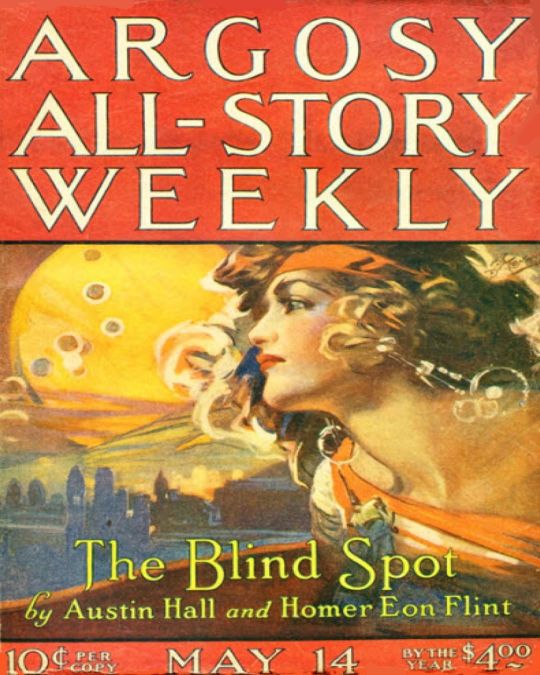
Burroughs’ two classics, along with the pseudo-scientific works of H. G. Wells and his American counterpart, George Allan England, would serve as templates for much of the science fiction written over the next twenty-five years, generating a type of story best known as “the scientific romance.” The Munsey chain in particular worked to develop this school of fiction, creating a stable of writers to contribute such stories. Austin Hall's and Homer Eon Flint's “The Blind Spot” -- serialized in six parts in ARGOSY ALL-STORY WEEKLY beginning with the May 14, 1921 number -- was one of many early examples of "science fiction" found in the Munsey magazines. The front cover art was by P. J. Monahan. https://www.instagram.com/p/B8cpX6mHcrD/?igshid=17tky5mgih33i
0 notes
Text
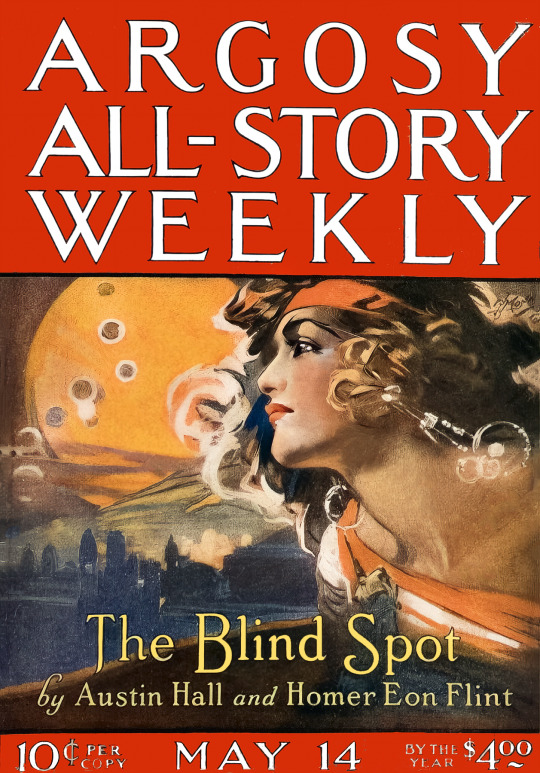
"The Blind Spot" Argosy All-Story Weekly, May 14, 1921 Cover by P. J. Monahan
#P. J. Monahan#argosy#argosy all-story weekly#the blind spot#vintage#scifi#scifi art#science fiction#science fiction art#art#illustration#painting#1921#1920s
41 notes
·
View notes
Text
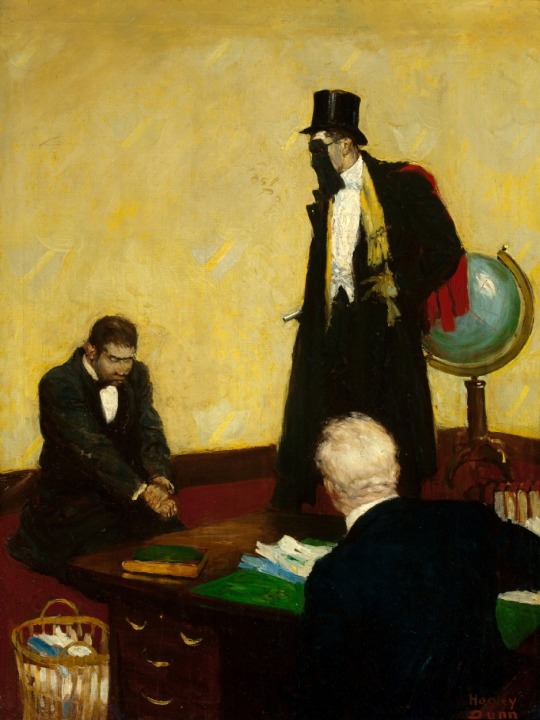
New Story Magazine Mar 1915
Harvey Dunn

People's Magazine Nov 1914
Harvey Dunn

The All-Story Mar 1914
Frederic W Small

Motor Age Magazine 1913
Clinton Pettee

The All-Story Sep 1913
Patrick J Monahan

The All-Story Jul 1913
Clinton Pettee

The Cavalier Nov 23 1912
Charles David Williams

The All-Story Nov 1912
Clinton Pettee

The All-Story Oct 1912 (first Tarzan story)
Clinton Pettee

Argosy Oct 1912
Modest Stein
#golden age art#pulp magazine art#pulp art#pulp art 1912#Argosy#Modest Stein art#pulp art 1914#People's Magazine#Harvey Dunn art#pulp art 1915#New Story Magazine#The Cavalier#C D Williams art#Fred W Small art#P J Monahan art#Clinton Pettee art#The All-Story#Motor Age Magazine#byronrimbaud
2 notes
·
View notes
Text

Cupid's Diary Nov 19 1924
Patrick J Monahan
1 note
·
View note
Text

People's Story Magazine Sep 10 1922
Edgar Franklin Wittmack
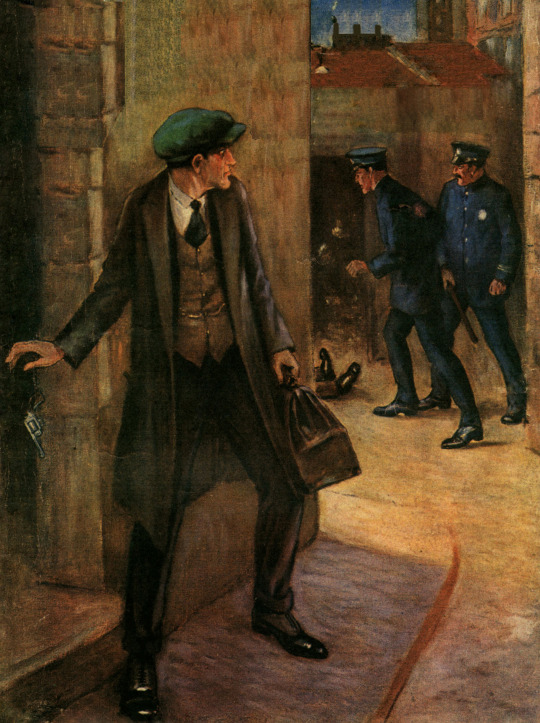
Black Mask Jul 1922
William Grotz

Argosy All-Story Weekly Feb 18 1922
Patrick J Monahan
#golden age art#pulp magazine art#pulp art#pulp art 1922#Black Mask#William Grotz art#People's Story Magazine#Edgar Franklin Wittmack art#Argosy All-Story Weekly#P J Monahan art#byronrimbaud
1 note
·
View note
Text

Love Story Magazine May 15 1926
Patrick J Monahan

Love Story Magazine Jan 23 1926
Patrick J Monahan
#golden age art#.#pulp magazine art#pulp art#pulp art 1926#Love Story Magazine#P J Monahan art#byronrimbaud
0 notes
Text

Science and Invention Apr 1924
Howard V Brown

People's Magazine Mar 15 1924
Patrick J Monahan
#golden age art#pulp magazine art#pulp art#pulp art 1924#Science and Invention#Howard V Brown art#People's Magazine#P J Monahan art#byronrimbaud
1 note
·
View note
Text

Black Mask Oct 1 1923
John Decker

book cover - The Girl From Hollywood - Aug 1923
Patrick J Monahan

Argosy All-Story Weekly May 5 1923
Patrick J Monahan
#golden age art#pulp magazine art#pulp art#pulp art 1923#Black Mask#John Decker art#Argosy All-Story Weekly#P J Monahan art#book cover art#The Girl From Hollywood#byronrimbaud
0 notes
Text

Detective Story Magazine Aug 27, 1921
John Coughlin

Argosy All-Story Weekly May 7 1921
Glen White = Patrick J Monahan

Argosy All-Story Weekly Feb 12 1921
Patrick J Monahan
#golden age art#pulp magazine art#pulp art#pulp art 1921#Detective Story Magazine#John Coughlin art#Argosy All-Story Weekly#P J Monahan art#byronrimbaud
0 notes
Text

Detective Story Magazine Nov 25 1919
John Coughlin

Detective Story Magazine Apr 29 1919
John Coughlin

All-Story Weekly Feb 15 1919
Frederic W Small

All-Story Weekly Nov 24 1917
Frederic W Small

All-Story Weekly Aug 9 1919 (first Zorro story)
Patrick J Monahan

People's Magazine Jul 1917
Patrick J Monahan

All-Story Weekly Mar 31 1917
Frederic W Small

All-Story Weekly Mar 3 1917
Frederic W Small

All-Story Weekly Feb 3 1917
Patrick J Monahan
#golden age art#pulp magazine art#pulp art#pulp art 1917#People's Magazine#P J Monahan art#pulp art 1919#Detective Story Magazine#John Coughlin art#All-Story Weekly#Fred W Small art#byronrimbaud
0 notes
Text
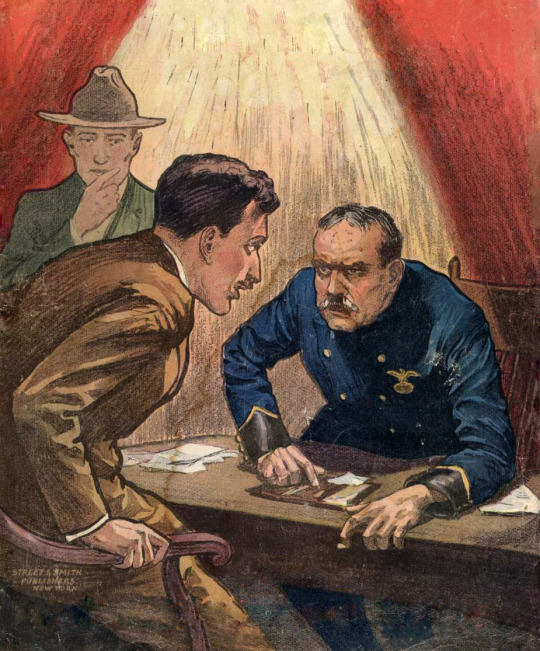
Detective Story Magazine Jan 5 1917
John Coughlin

Detective Story Magazine Aug 5 1916
John Coughlin

All-Story Weekly Apr 8 1916
Patrick J Monahan
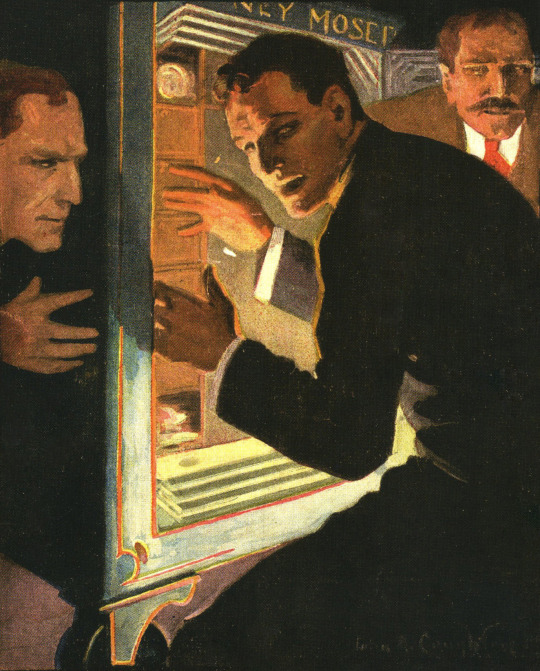
Detective Story Magazine Dec 20 1915
John Coughlin

All-Story Weekly Nov 13 1915
Patrick J Monahan
#golden age art#pulp magazine art#pulp art#pulp art 1915#Detective Story Magazine#John Coughlin art#pulp art 1916#pulp art 1917#All-Story Weekly#P J Monahan art#byronrimbaud
1 note
·
View note
Photo
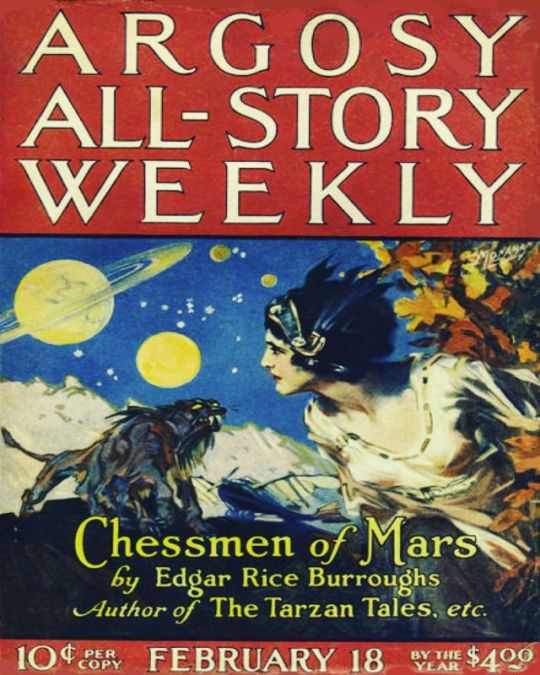
We’ve been looking at WEIRD TALES for the last month as part of the PulpFest 2019 celebration of “Children of the Pulps & Other Stories.” It’s part of our exploration of science fiction, a genre that grew and evolved in the pulp magazines of the early twentieth century. Here’s a copy of ARGOSY ALL-STORY WEEKLY for February 18, 2022, with cover art by P. J. Monahan, illustrating Edgar Rice Burroughs’ “Chessmen of Mars.” Burroughs’ scientific romances were forerunners to the science fiction that would appear in pulps such as WEIRD TALES. https://www.instagram.com/p/ByJF7jiBbNR/?igshid=19aycam0o5noh
0 notes